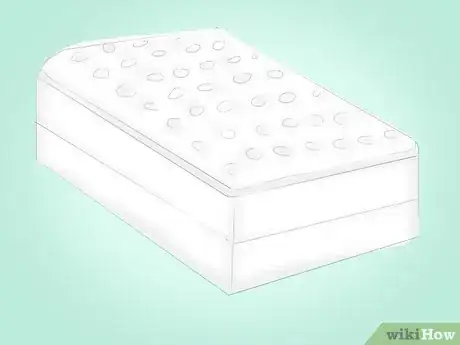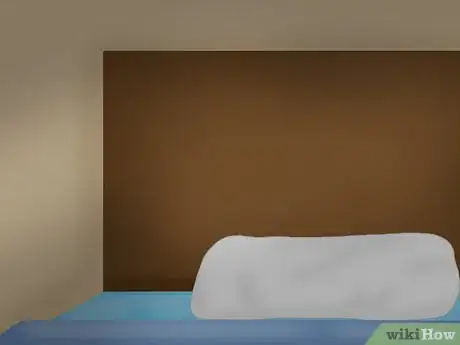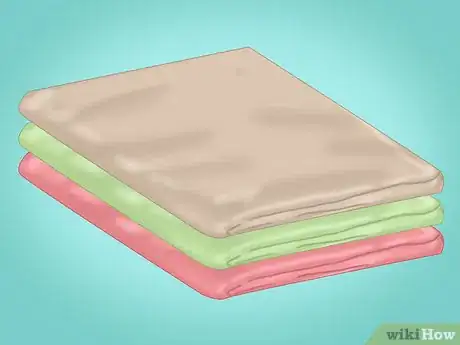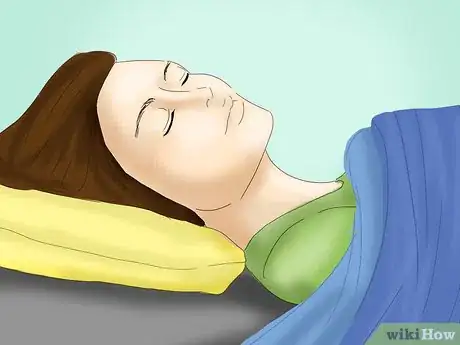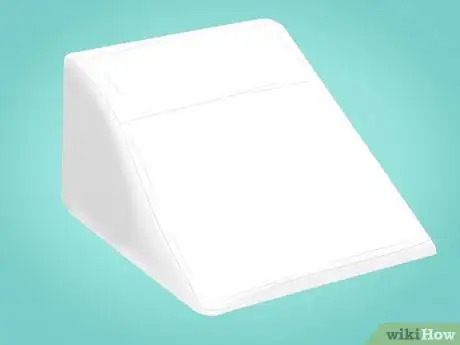This article was co-authored by Garrison Hullinger. Garrison Hullinger is an Interior Designer and the President of Garrison Hullinger Interior Design (GHID). With more than 15 years of experience, he specializes in client-centered design that balances beauty and warmth with comfort and functionality. Garrison and GHID’s work has been featured in numerous publications such as The New York Times, The Wall Street Journal, and Interior Design Magazine. Garrison attended Oklahoma Christian University.
There are 14 references cited in this article, which can be found at the bottom of the page.
This article has been viewed 308,957 times.
Are you tossing and turning in bed all night because of discomfort? Just can't seem to get comfortable? Part of good sleep is having a cozy environment. Here are some ways to produce such an environment.
Steps
Preparing your Bed
-
1Find a comfortable mattress. A good mattress is the foundation for getting cozy in bed. You may need a new mattress if your mattress is 5 to 7 years old, you wake up with pain or stiffness, your mattress sags or has lumps, or you find that you get better sleep when you are not in your bed.[1] Your mattress should be comfortable, support your body, and keep your spine in the same shape as when you are standing.
- If you cannot afford a new mattress, try a mattress topper or a thick mattress pad. There are many options including feather toppers, egg crate toppers, and memory foam toppers.
- It is important to invest in a good mattress that will last because you spend about a third of your life sleeping, and this should be on a quality mattress that meets your comfort needs.
- Always test a mattress before you buy it. Take off your shoes, lie down on the mattress, and try different sleeping positions. It is best to test the mattress for 20 minutes to get a good idea of how it would feel to sleep on the mattress.[2]
-
2Create a pleasant smelling room. Scent is very powerful and contributes to the ambiance of your room. Light some candles or use a room spray that you enjoy. Lavender is a scent that is calming, promotes sleep, and can help you feel calmer. Any scent that you like will help create a cozy environment.
- Some stores have pillow sprays that come in scents like chamomile or lavender. Spray the desired amount lightly on your pillow and blankets; if you like the scent, this can actually help you be more comfortable.
Advertisement -
3Adjust the lighting in your bedroom. The amount of light in your bedroom affects how you feel. Natural light is best during the day, but dimmed lighting is best at night. Bedside lamps create softer lighting than overhead lights. Your blinds and curtains should also keep light from coming into your bedroom at night.
- You can also replace your light switch with a dimmer to better control the lighting.
- A low watt bulb (40 watt or lower) is also a good lighting option.[3]
- You can put attachments on each side of the wall to hang curtains around a bed without putting holes in the ceiling.
- If you want to hang a curtain swag without a rod, you can use a dowel rod.
- If you have an old extension stick from a painter's roller or a broom, place it on a bracket and put it across the top of the window.
-
4Get comfortable sheets. Your sheets should be the right size for your mattress so that they do not tear or come off when you are in bed. Cotton sheets are the most popular and do well in the warmer months. Silk sheets are very soft and retain heat. They are useful for cooler nights. Flannel sheets are very warm and are best in colder climates. Synthetic fabrics (e.g. polyester) are less expensive, but can still be comfortable.
- Change your sheets once a week.
- Look for cotton sheets that are 100% pure or Egyptian cotton and that have a high thread count.
- Flannel sheets are measured in ounces and heavier sheets are higher quality sheets.
-
5Find soft pillows. Everyone needs quality pillows. Some people prefer pillows that are shaped to support your neck or head, other people prefer them well stuffed, while others like them soft. At the end of the day, choose pillows that work for you after a little trial and error.
- Load your bed with pillows of difference sizes and shapes. You may want a full body pillow if you sleep alone, or a wedge pillow to put behind your neck.[4]
- Firm pillows are best if you sleep on your side. Medium pillows are best if you sleep on your back. Soft pillows are best if you sleep on your stomach.
- Clean or air pillows regularly and replace once every one to two years for complete freshness.
-
6Tuck your sheets and blankets. Having a nicely made bed will make you want to get in it. Start with a fitted sheet on your bed. Then tuck your top sheet and/or blanket in on the sides and foot of your bed. This will create a cocoon and keep your feet from getting cold.[5] Nothing is worse than being all warm and toasty in your bed, but your feet are hanging out.
-
7Get soft, fluffy bedding. Top your bed with a comforter, quilt, blanket, or duvet that is comfortable to you. You may need to change your bedding based on the climate and season. For example, a lightweight, cotton bedspread may be best in the summer, but a thick, down comforter may be best in the winter months.
Getting Yourself Ready
-
1Adjust the temperature. Cooler temperatures are better for sleeping. Temperatures between 60 and 67 degrees Fahrenheit are ideal for sleeping. Temperatures below 54 degrees or above 75 degrees can disrupt your sleep.[8] A cooler temperature can help you fall asleep and will make you want to snuggle up in your bed.
- You can also try turning on a fan to keep your room cool.
-
2Take a shower or bath before going to bed. A shower will clean you, warm you up, help to soften your skin, remove allergens that have attached themselves to you during the course of the day, and help you to feel sleepy. When you get out, you can also apply some lavender-scented lotion to help you drift off to sleep. Of course, it's optional, but can help get you to sleep faster.
-
3Wear comfortable nightclothes. Wear comfortable gear, such as a t-shirt and shorts, maybe socks too as they can be very warm. Try to avoid wearing very heavy nightclothes in the summer, as you will get too hot. On the other hand, wearing very light clothing in the winter may make you colder. Try to dress accordingly; cold feet or sweating profusely can keep you awake all night.
-
4Avoid caffeine and alcohol before bed. Alcohol may help you fall asleep more quickly, but it may keep you from getting deep sleep. Caffeine (e.g. coffee, tea, sodas, and chocolate) is a stimulant that can cause insomnia, disturb your sleep, or cause you to urinate more. You do not want to have to get out of bed to use the bathroom throughout the night.[9]
- Cut off caffeine and alcohol several hours before you plan to go to bed.[10]
-
5Create a nighttime routine. You want to as relaxed as possible when you go to sleep. If your mind tends to race when you are in bed, make a to-do list for the next day to calm your mind. You can also keep a journal on your nightstand to write out anything that is making you feel stressed. Your routine may also include yoga, meditation, Pilates, or self-massage which can help you feel relaxed and sleep more soundly.
- A foam roller or tennis ball can be used to massage your own body.
- Avoid vigorous exercise that may keep your body aroused and make it difficult for you to fall asleep.
-
6Try sleeping in a different position. Putting a pillow in between your knees and lying on your side is a surprisingly comfortable one for many people.
Staying in Bed When You're Sick
-
1Sleep with layers of blankets. When you are sick, your body may fluctuate between feeling too cold and feeling too warm. Use layers of blankets instead of a single comforter so that you can control your temperature better. This will also keep you from having to leave your bed to adjust the thermostat or get additional covers.[11]
-
2Prepare your nightstand. Keep everything you may need on your nightstand next to your bed. You do not want to have to get out of bed to get things you may need during the day or night. You may want to keep a glass of water, tissues, medicine, and some honey (to soothe your throat) on your nightstand. Also, put other items you may want such as books or magazines on your nightstand.[12]
- If you do not have room on your nightstand, put all of your medicines in a plastic box that you keep near your bed.[13]
-
3Consider a wedge pillow. A wedge pillow will support your back, neck, and shoulders while you are in bed. This will allow you to read or use your computer in a comfortable position without straining.[14] If you do not have a wedge pillow, organize your pillows to support your back while you are sitting upright.
-
4Use a bed tray. A bed tray is a good place to put your bowls, beverages, and food while you are in bed. This will keep you from spilling food or drink in your bed. You can also sit your laptop on the tray as well. Laptops tend to overheat when sitting on your lap or directly on your bed.[15]
- You can also use a laptop pillow if you do not have a bed tray.[16]
References
- ↑ http://bettersleep.org/pdfs/BetterSleepGuide_English.pdf
- ↑ http://bettersleep.org/mattresses-and-more/choosing-the-best-mattress
- ↑ http://www.apartmenttherapy.com/7-ways-to-cozy-up-your-bedroom-for-fall-211089
- ↑ http://www.besthealthmag.ca/best-you/sleep/12-ways-to-make-your-bedroom-more-sleep-friendly
- ↑ http://www.purewow.com/home/10-Steps-to-Your-Coziest-Bed-Ever/slide2
- ↑ http://www.apartmenttherapy.com/get-the-look-faux-fur-throw-186411
- ↑ http://www.apartmenttherapy.com/five-amazing-blankets-to-cozy-up-to-211099
- ↑ http://www.huffingtonpost.com/dr-christopher-winter/best-temperature-for-sleep_b_3705049.html
- ↑ https://sleepfoundation.org/sleep-topics/caffeine-and-sleep
- ↑ https://sleepfoundation.org/sleep-topics/caffeine-and-sleep
- ↑ http://www.amerisleep.com/blog/better-sleep-when-sick/
- ↑ http://www.amerisleep.com/blog/better-sleep-when-sick/
- ↑ http://www.apartmenttherapy.com/tips-for-surviving-sick-days-a-158672
- ↑ http://bettersleep.org/mattresses-and-more/pillows/pillow-types/
- ↑ http://www.digitaltrends.com/computing/what-happens-if-you-use-your-laptop-in-bed/
- ↑ http://www.apartmenttherapy.com/if-you-simply-must-work-from-bed-5-comfortable-solutions-188698
